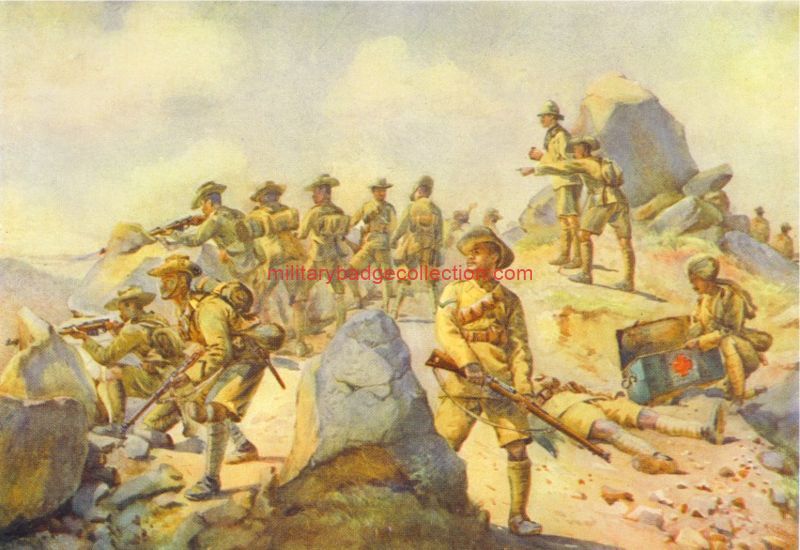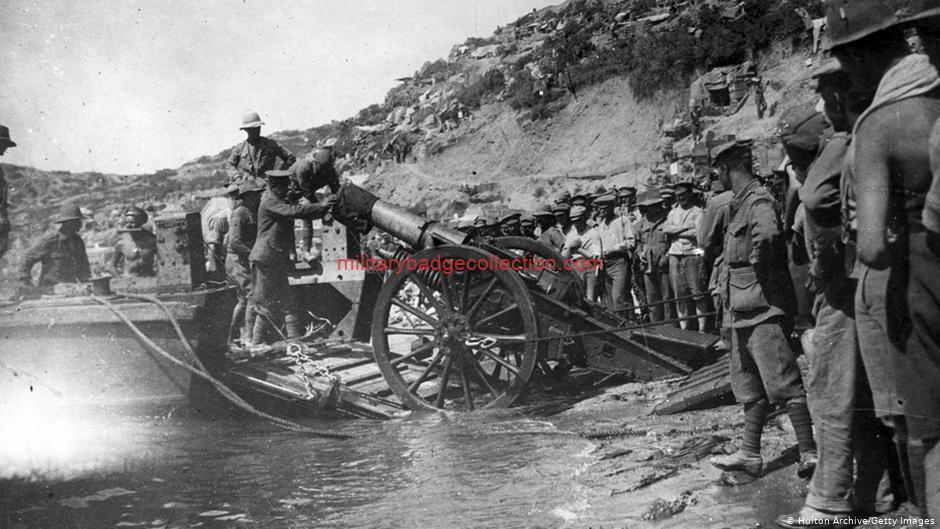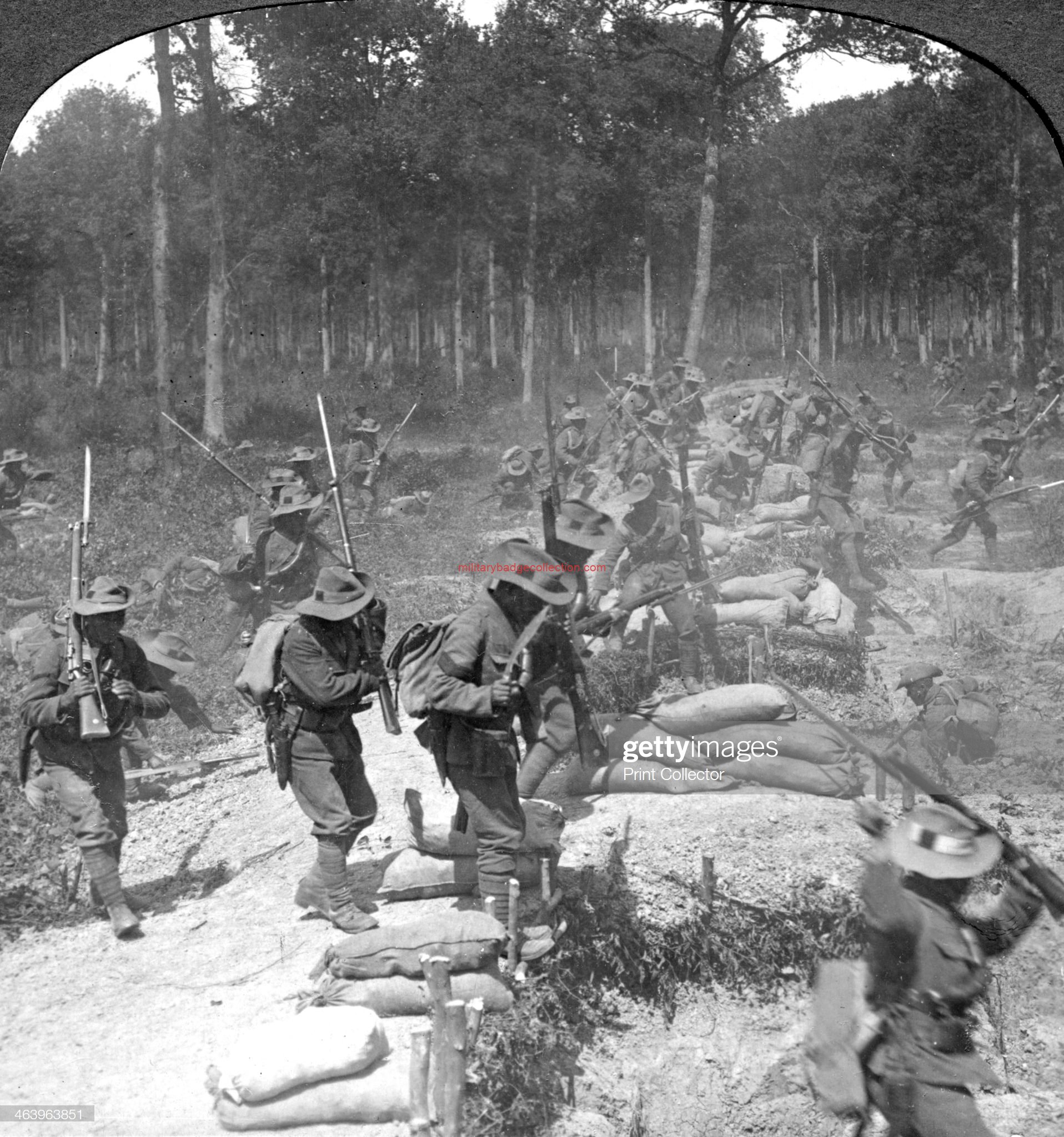18: 4th Gurkha Rifles
Badges of 4th Gurkha Rifles
4th Prince of Wales’s Own Gurkha Rifles
The 4 Gorkha Rifles is an infantry regiment of the Indian Army. It was originally raised in 1857 as part of the British Indian Army, but after India’s independence in 1947 it was one of six Gurkha regiments transferred to the Indian Army. The regiment was formerly known as the 4th Prince of Wales’s Own Gurkha Rifles, but after it was transferred to the Indian Army its name was changed upon India becoming a republic. Since its establishment over 150 years ago, the regiment has fought in many conflicts and earned many battle honours, including the Second Afghan War, the Boxer Rebellion, the First World War, the Second World War and most of the wars and Counter Insurgency Operations India has fought since independence.
Early history
In 1857, it was decided to augment the existing Gurkha regiments by raising another. Initially, this was known as the Extra Goorkha Regiment, before being numbered as the 19th Regiment of Bengal Native Infantry. In 1861 it was finally designated as the 4th Goorkha Regiment.
The regiment’s first major action came during the Second Afghan War, although in this time it also served on the North-West Frontier and during the Boxer Rebellion in 1900.
The regiment’s first Victoria Cross came during operations in Somalia during the Third Somaliland Campaign in 1903, when then Captain William George Walker risked his life in an attempt to save the life of another officer who had been wounded during earlier fighting. Walker’s VC was, however, earning serving in the Somali Camel Corps, not the 4th Gorkhas.
First World War
During the First World War, the 1st Battalion served in France, participating in the battles of Givenchy, Neuve Chapelle and Ypres, while the 2nd Battalion saw service in Mesopotamia. A 3rd Battalion was authorised to be raised, but due to a clerical error, the 4th Battalion, 3rd Gurkha Rifles was raised instead of the 3rd Battalion, 4th Gurkha Rifles.
In 1924, the regiment became the 4th Prince of Wales’s Own Gurkha Rifles, with the Prince of Wales becoming Colonel-in-Chief.
John Masters’ Bugles and a Tiger is a memoir that discusses, in part, his time with the regiment in the 1930s and 1940s.
Second World War
The regiment saw service in most theatres during the Second World War, including the Middle East, North Africa, Italy, and the Far East.
The 1st Battalion served throughout the Burma Campaign. During the early part of the campaign the battalion fought in the Battle of Sittang Bridge. It was commanded at this engagement and during the subsequent retreat into India by Lieutenant Colonel “Joe” Lentaigne, who later succeeded Major General Orde Wingate in charge of the Chindits. Later, during the Battle of Imphal, the battalion suffered nearly 100% casualties (higher among officers). The 2nd Battalion saw service in Iraq and Syria. It was overrun by two Bersaglieri battalions of the Italian Trento Division storming the fortress of Mersa Matruh on 29 June 1942, but was rebuilt and subsequently fought in the Italian Campaign.
The 3rd Battalion was finally raised in 1940. It saw service with the Chindits in Burma. The 4th Battalion was raised in 1941. It also fought in Burma, distinguishing itself by storming Mandalay Hill in 1945.
A prominent figure who was part of the 4th Gurkha Rifles during the thirties and the Second World War was the author John Masters, who participated in operations in Iraq, on the North West Frontier, the Second Chindit Operation, the capture of Mandalay and at one point commanded the 3rd Battalion of the regiment. His books ‘Bugles and a Tiger’ and ‘The Road past Mandalay’ portray life in the Indian Army and the 4th Gurkha Rifles.
Post 1947
Following India’s independence in 1947, the 4th Gurkhas was one of the Gorkha regiments to be allocated to the Indian Army. In 1950, when India became a republic, the regiment’s name was changed to the 4th Gorkha Rifles as it was decided to adopt the Indian spelling.
The centre at Bakloh was abandoned as the Gorkha regimental training centres were merged. As a result, the 4th’s training centre was merged with that of the 1st Gorkha Rifles and located at Subathu.
The 4th Gorkhas have distinguished themselves in the three Indo-Pakistan Wars of 1947, 1965 and 1971 being awarded battle and theatre honours for all three conflicts. The third battalion fought a fine action at Bilafond La, at heights of nearly 20,000 feet (6,100 m) in 1987.
The 1st Battalion (JETHI) was awarded the COAS Unit Citation in 2002, for its performance in counter terrorism operations in Kupwara district, Kashmir. The Battalion was commended for neutralizing 94 Foreign Terrorists, in a number of operations in Tangdhar, Panzgam and Lolab. The Battalion suffered two fatal casualties, Capt Anirban Bandhyopadhyay and Nb Sub Deb Bahadur Thapa. They were posthumously awarded the Sena Medal and the Kirti Chakra respectively.
The Regiment is unique in the Indian Army, as the battalions do not celebrate individual Raising Days. Regimental Day (called Neuve Chapelle–Baghdad Day) is celebrated on 11 March by the entire Regiment, commemorating the 1st Battalion’s entry in the Battle of Neuve Chapelle in France and the 2nd Battalion’s entry into Baghdad on that day (albeit in different years), during the First World War.
The Regiment derives most of its drills and standards from the British ‘Greenjackets’, and marches ‘quickstep’ at 180 paces a minute. The Pipeband of the First Battalion is one of the finest in the Indian Army. The uniform and insignia are Spartan, and a healthy disdain for pomp or being ‘Red’ is central to the Regiment’s identity and professional approach. The 4th Gorkhas are also the only Regiment in the Indian Army who wear the Lanyard (a plain Black) over the Jersey. This is again taken from the British Rifles Regiment, where only those exercising command over men wear a lanyard for the whistle. The Right hand occupied by the sword, the left is free to draw the wistle – easier done from the Right pocket. Many erronously believe that lanyard is worn on the Right shoulder only by the erstwhile ‘Royal’ regiments, and the 4th Gurkhas do so because they were the ‘Prince of Wales’ Own’. This is wrong. A regiment’s ‘Royal’ status is marked by the colour of the lanyard (Red) and the prefix ‘Royal’ only. Many Indian Army units have dropped their pre-independence prefix of ‘Royal’, but still wear the Red Lanyard. (5 GR, Garh Rif.. etc)
The Regiment celebrated its Sesquicentenary in 2007.
Battle honours
Pre First World War
- Ali Masjid
- Kabul 1879
- Kandahar 1880
- Afghanistan 1878–80
- Chitral
- Waziristan 1895
- Tirah
- Punjab Frontier
- China 1900.
First World War
- Givenchy 1914
- Neuve Chapelle
- Ypres 1915
- St. Julien
- Aubers
- Festubert 1915
- France and Flanders 1914–15
- Egypt 1916
- Tigris 1916
- Kut al Amara 1917
- Baghdad
- Mesopotamia 1916–18
- Gallipoli 1915
- N.W. Frontier India 1917
- Baluchistan 1918.
Inter War Period
Second World War
- Iraq 1941
- Syria 1941
- The Cauldron
- North Africa 1940–43
- Trestina
- Monte Cedrone
- Italy 1943–45
- Pegu 1942
- Chindits 1944
- Bishenpur
- Shwebo
- Mandalay
- Burma 1942–45.
Post Independence
- Punch
- Gurais
- Jammu and Kashmir 1947–48
- Punjab 1965
- Jammu and Kashmir 1971. COAS Unit Citation, 2002.
Gallantry awards
Pre-independence
1 Victoria Cross 1 Commander of the British Empire 10 Distinguished Service Order – 1 Order of the British Empire – 1 Bar to DSO – 24 Military Cross – 1 Bar to MC – 1 Member of the British Empire – 1 French Legion of Honour – 96 Mention in Despatches – 9 Order of British India – 15 Indian Order of Merit – 6 IDM – 42 Indian Distinguished Service Medal – 1 Croix De Guerre – 11 Medialle Militaire – 1 Bronze Medal for Military Valour – 1 Medal of Saint George – 2 Star of Nepal
Post-independence
3 Param Vishishth Seva Medal – 1 Maha Vir Chakra – 1 Kirti Chakra – 3 Ati Vishishtha Seva Medal – 5 Vir Chakra – 2 Shaurya Chakra – 1 Yudh Seva Medal – 24 Sena Medals – 6 Vishishtha Seva Medals – 9 Mention in Dispatches – 40 Commendation cards.


